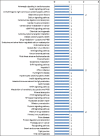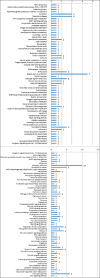Investigation of Circulating Serum MicroRNA-328-3p and MicroRNA-3135a Expression as Promising Novel Biomarkers for Autism Spectrum Disorder
- PMID: 30984518
- PMCID: PMC6454235
- DOI: 10.2478/bjmg-2018-0026
Investigation of Circulating Serum MicroRNA-328-3p and MicroRNA-3135a Expression as Promising Novel Biomarkers for Autism Spectrum Disorder
Abstract
Circulating microRNAs (miRNAs) are emerging as promising diagnostic biomarkers for autism spectrum disorder (ASD), but their usefulness for detecting ASD remains unclear. Nowadays, development of promising biomarkers for ASD remains a challenge. Recently, dysregulation of the miRNAs expression in postmortem brain tissue, serum and peripheral blood, have been associated with ASD. Circulating miRNAs are known to be secreted by a number of different cells and can interpose delivery of information into receiver cells, thus affecting their functions. Based on this fact, it is supposed that serum miRNAs could be a novel class of biomarkers for prognosis or diagnosis of pathological disorders including ASD. In the current research, we investigated whether the expression patterns of circulating miRNAs showed dysregulation in subjects diagnosed with ASD. Expression levels of serum miR-328-3p and miR-3135a were analyzed by quantitative reverse transcription polymerase chain reaction (qRT-PCR) method of subjects diagnosed with ASD in comparison with healthy control subjects. Our data showed that miR-328-3p and miR-3135a were substantially down-regulated in ASD patients than in those of healthy control subjects. Moreover, target gene analysis of altered serum miRNAs displayed that these molecules targeted 162 genes denoted as unique validated targets in the miRWalk database, 71 of which appear to participate in biological pathways involved in synaptic pathways and neurodegenerative condition such as Alzheimer, Huntington and Parkinson diseases. Finally, the results strongly suggested that dys-regulated serum miRNAs might be involved in molecular pathways associated with ASD and miR-328-3p and miR-3135a have the potential to be promising novel biomarkers for ASD.
Keywords: Autism spectrum disorder (ASD); MicroRNA (miRNA) expression profiling; Serum miRNAs; Stem-loop quantitative reverse transcription polymerase chain reaction (qRT-PCR).
Figures






Similar articles
-
Profiling of Circulating Serum MicroRNAs in Children with Autism Spectrum Disorder using Stem-loop qRT-PCR Assay.Folia Med (Plovdiv). 2017 Mar 1;59(1):43-52. doi: 10.1515/folmed-2017-0009. Folia Med (Plovdiv). 2017. PMID: 28384108
-
Systematic Review and Bioinformatic Analysis of microRNA Expression in Autism Spectrum Disorder Identifies Pathways Associated With Cancer, Metabolism, Cell Signaling, and Cell Adhesion.Front Psychiatry. 2021 Oct 21;12:630876. doi: 10.3389/fpsyt.2021.630876. eCollection 2021. Front Psychiatry. 2021. PMID: 34744804 Free PMC article.
-
Identification of serum microRNA signatures associated with autism spectrum disorder as promising candidate biomarkers.Heliyon. 2021 Jul 3;7(7):e07462. doi: 10.1016/j.heliyon.2021.e07462. eCollection 2021 Jul. Heliyon. 2021. PMID: 34286132 Free PMC article.
-
Profiling olfactory stem cells from living patients identifies miRNAs relevant for autism pathophysiology.Mol Autism. 2016 Jan 8;7:1. doi: 10.1186/s13229-015-0064-6. eCollection 2016. Mol Autism. 2016. PMID: 26753090 Free PMC article.
-
miRNAs as biomarkers of autism spectrum disorder: a systematic review and meta-analysis.Eur Child Adolesc Psychiatry. 2024 Sep;33(9):2957-2990. doi: 10.1007/s00787-023-02138-3. Epub 2023 Feb 3. Eur Child Adolesc Psychiatry. 2024. PMID: 36735095 Free PMC article.
Cited by
-
The role of Extracellular Genomic Materials (EGMs) in psychiatric disorders.Transl Psychiatry. 2023 Jul 18;13(1):262. doi: 10.1038/s41398-023-02549-5. Transl Psychiatry. 2023. PMID: 37464177 Free PMC article. Review.
-
A systematic review of non-coding RNA genes with differential expression profiles associated with autism spectrum disorders.PLoS One. 2023 Jun 15;18(6):e0287131. doi: 10.1371/journal.pone.0287131. eCollection 2023. PLoS One. 2023. PMID: 37319303 Free PMC article.
-
Circulating miRNAs, Small but Promising Biomarkers for Autism Spectrum Disorder.Front Mol Neurosci. 2019 Oct 11;12:253. doi: 10.3389/fnmol.2019.00253. eCollection 2019. Front Mol Neurosci. 2019. PMID: 31680857 Free PMC article. Review.
-
Molecular Dysregulation in Autism Spectrum Disorder.J Pers Med. 2021 Aug 27;11(9):848. doi: 10.3390/jpm11090848. J Pers Med. 2021. PMID: 34575625 Free PMC article. Review.
-
Emerging Role of Non-coding RNAs in Autism Spectrum Disorder.J Mol Neurosci. 2022 Feb;72(2):201-216. doi: 10.1007/s12031-021-01934-3. Epub 2021 Nov 12. J Mol Neurosci. 2022. PMID: 34767189 Review.
References
-
- Bartel DP. MicroRNAs: Genomics, biogenesis, mechanism and function. Cell. 2004;116(2):281–297. - PubMed
-
- Mattick JS, Makunin IV. Non-coding RNA. Hum Mol Genet. 2006;15(15):R17–R29. - PubMed
-
- Fombonne E. Epidemiology of pervasive developmental disorders. Pediatr Res. 2009;65(6):591–598. - PubMed
-
- Developmental Disabilities Monitoring Network Surveillance Year. Principal Investigators, Centers for Disease Control and Prevention (CDC). Prevalence of autism spectrum disorder among children aged 8 years– autism and developmental disabilities monitoring network, 11 sites, United States, 2010. MMWR Surveill Summ. 2010;2014;63(2):1–21. - PubMed
-
- Rutter M. Incidence of autism spectrum disorders: Changes over time and their meaning. Acta Paediatr. 2005;94(1):2–15. - PubMed
LinkOut - more resources
Full Text Sources
